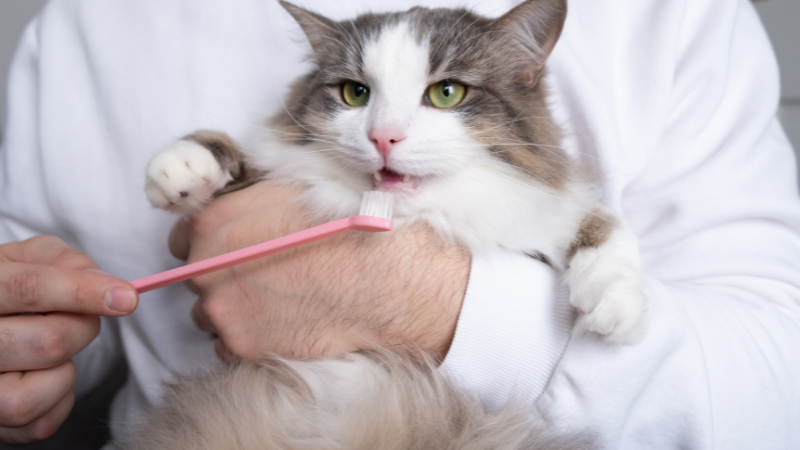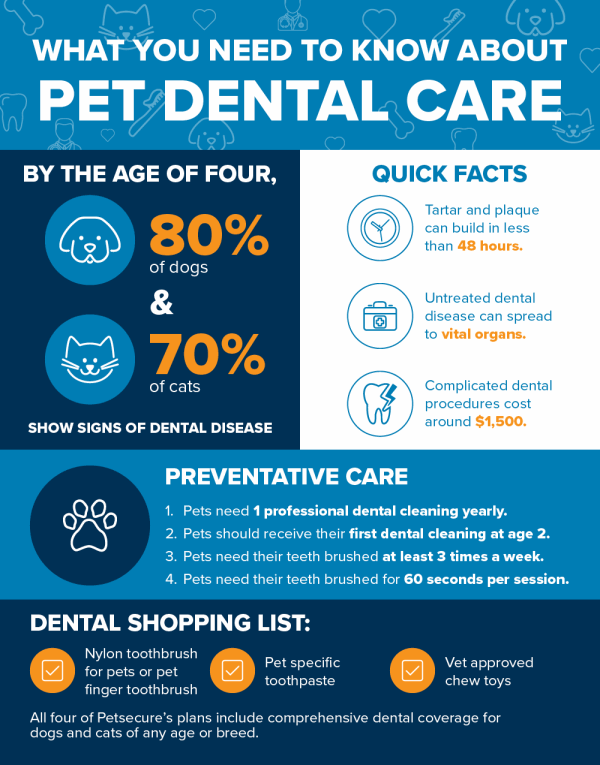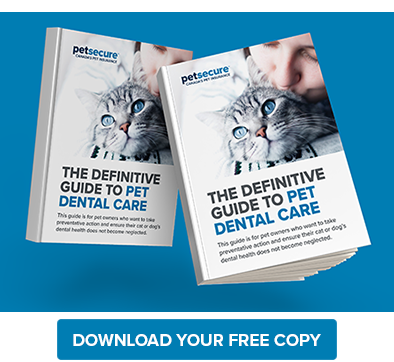
Have you ever brushed your cat or dog’s teeth? Did you know that dogs and cats have baby teeth?
Do you wonder how often you should brush your pet’s teeth? How the heck do you get a toothbrush in your cat’s mouth without feeling the wrath of their claws?
Examining your pet’s mouth, teeth and gums is a standard part of yearly checkups at the vet, but there’s a lot you can do throughout the year to ensure their pearly whites stay pearly and white.
Keep reading to learn more about how you can improve your pet’s dental health!
How to brush your cat or dog’s teeth
It’s quite simple. All you need is something soft, a pet, and patience.
Just like in people, unhealthy teeth and gums left untreated can lead to serious health problems. Home dental care promotes healthy teeth and gums by decreasing tartar build-up.
If you brush your pets’ teeth regularly, you are more likely to notice problems like broken or misaligned teeth, bad smells, or abnormal lumps and bumps inside the mouth.
Watch Petsecure’s Veterinarian Colleen Fisher show the steps needed to teach your pet to love dental care!
Want to brush your pet's teeth? Follow these 6 steps!
Step #1
Put the toothbrush away for now.
Step #2
Incorporate cooperative care techniques. You want your pet to choose to work with you. Before brushing, play some fun games to create a positive environment
Step #3
Start with using something soft in their mouth, like a soft cloth. Gently rub their teeth and gums allowing them to become accustomed to the action. With some small dogs and cats, this may be all or as much as they can tolerate.
Step #4
Introduce the toothbrush as a toy. Try using a small amount of peanut butter or even some canned food. Let your pet simply lick, explore, and chew the toothbrush.
Step #5
Once your pet becomes used to the toothbrush, start slowly and gradually cleaning more teeth with each session. To create a positive learning experience, stop brushing and reward your pet before they pull away or struggle. This technique allows your pet to choose to take part in their oral care.
Step #6
Preventing plaque buildup entirely with home brushing techniques isn’t possible. To get the greatest oral care benefit, you need to brush your pet’s teeth daily.
Knowing how to brush your pet’s teeth may seem impossible, but it’s preventative care that is worth the time and energy.
How to tell if my pet needs a dental cleaning
Regular exams of your pet’s mouth are important for catching a dental disease in its early stages. Here are some other signs that may be related to dental diseases:- Bad breath
- Drooling more than usual
- Pawing at the mouth
- Difficulty chewing
- Loose or missing teeth
- Red or swollen gums
Why Veterinarians Recommend Dental Procedures
Examining and assessing your pet’s mouth, teeth and gums is a standard part of veterinary yearly checkups. Below are a few benefits of routine dental care:
- A pain-free mouth with fresh breath.
- A decrease in tooth loss, gum disease and need for extractions
- Prevention of complications from heart, liver, and kidney disease.
- Early intervention for oral and throat cancers.

If signs of dental problems are present during your pets’ checkup, an extensive exam that includes dental x-rays will be needed to assess the issue. Major extractions can double if not triple the cost of a dental procedure. An exam could identify:
- Broken or loose teeth
- Extra teeth or retained baby teeth
- Discoloured teeth
- Bad breath
- Swelling, pain, or bleeding in or around the mouth
- Plaque or tartar buildup
- Abnormal chewing, drooling, or food dropping
- Reduced appetite or refusing to eat
Contributing factors to dental diseases
Age
Dental disease is more noticeable in older pets but can appear as early as three years of age.
Breed
Persians and other flat-faced cats and smaller dog breeds are more likely to have overcrowded or misaligned teeth, making it difficult to keep their teeth clean. Therefore, they are more prone to gum disease and loose teeth. Read more about breeds and dental health here.
Food or diet
Sometimes pets with chronic conditions need to eat prescription foods. may benefit from dental cleaning to reduce secondary health complications.
Why Pet Dental Procedures are Worth the Cost
It is well known that dogs and cats receive much less preventive dental care compared with people. Even if you are brushing your pets’ teeth regularly, an exam and cleaning once per year could help identify diseases before they get worse.
This helps reduce or eliminate your pets’ pain and lessen treatments costs. We are encouraged to brush and floss our teeth daily, while most cats and dogs often have no or very minimal dental care at all.
-
Dental diets, special treats, and water additives don’t replace daily care.
-
Many pet owners only book a dental procedure once a significant dental disease has developed
-
Many pets need more than “routine cleanings” because their dental disease is advanced.
Anesthetics are necessary for dental procedures
While working in a pet’s mouth for any reason while they are awake, there is a high chance a staff member could get bitten. Pets can’t “sit still” with noisy or potentially scary equipment in their mouths. Even if well-behaved, sudden movement could result in major damage to the gums, cheeks, or tongues.
Suction tubes aren’t useable, and pets can’t rinse or spit. Anesthetized animals need an airway tube that protects the lungs from water, bacteria, and debris.Dogs and cats have more complicated tooth and root structures. Dental x-ray positioning, extractions, and surgery take hours.
A pet dental procedure has 12 steps:
-
Pre-anesthetic exam
-
Pre-anesthetic blood testing
-
Anesthesia and sedation to decrease your pet’s stress in the clinic
-
Intravenous fluid therapy or fluid therapy support
-
A complete examination of the neck, jaw, and mouth
-
Dental charting
-
Dental X-rays
-
Cleaning
-
Vet’s evaluation
-
Polishing
-
Fluoride
-
Post-anesthetic care
Petsecure pet health insurance dental coverage is One of a KIND!
Many pet insurance companies offer some form of dental coverage in their plans. But, it’s important to know that the coverage isn’t always created equal. When you sign up for a paid policy, after six months your pets’ dental coverage becomes available.Dental benefits renew on your policy anniversary which makes annual cleaning more affordable. If your veterinarian doesn’t recommend a dental procedure in the current year, the dental benefits can be used towards purchasing dental preventive products.
Petsecure Dental Includes:
- Routine Dental Prophylaxis (Cleanings)
- Tooth extractions and oral surgery
- Dental Radiographs
- Pre-anaesthetic/Pre-anesthetic Diagnostic Testing
- Anesthetic time, monitoring and IV fluids during the dental procedure
- Post Surgical Medications
- Dental preventive product coverage is available with a DIN (Drug Identification Number) or NPN (Natural Product Number) when recommended by your veterinarian.
In Summary
The gold standard of home dental care for cats and dogs is daily brushing. This habit will help you to find problems as soon as possible. Your clinic team will also check your pet’s teeth as part of annual wellness exams to advise whether it’s time for a teeth cleaning and comprehensive oral assessment.
Prevention and prompt veterinary care will minimize the impact of dental disease and help maintain your pet’s oral and overall health.
At Petsecure, we are proud to offer dental coverage for cats and dogs across Canada, and our plans are designed to fit anyone’s budget! Plans include more than just protection for unexpected accidents and illnesses.
Learn what’s covered by Petsecure and get a free quote today.

.png?lang=en-CA)